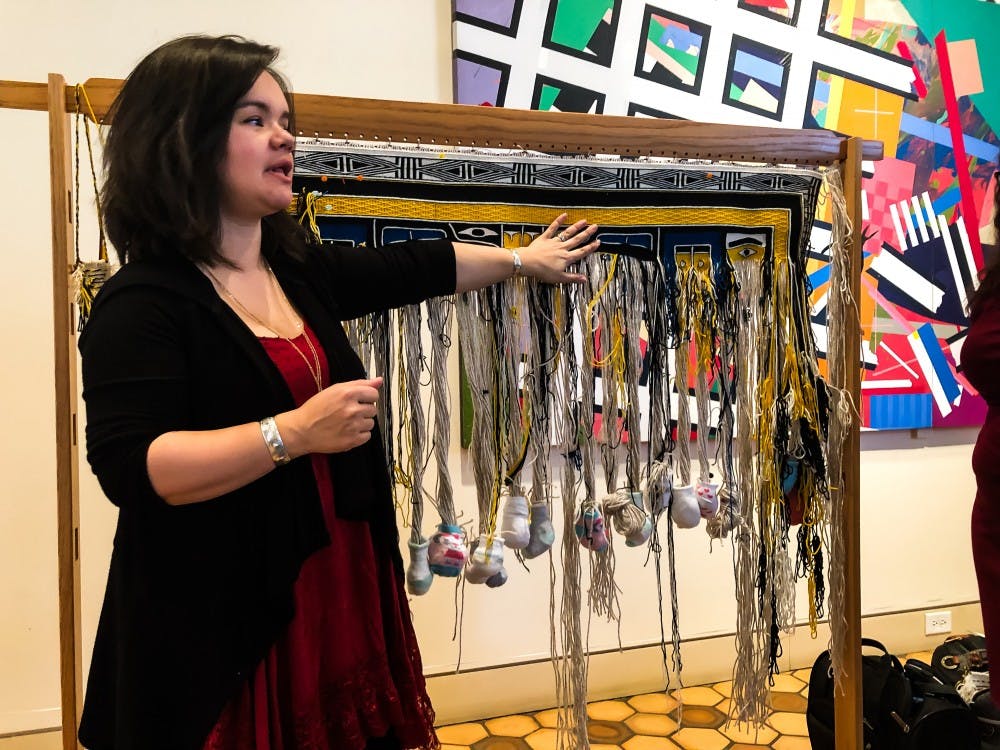Storytelling is an aspect of culture that is tied into nearly every form of contemporary media. Through books, movies, TV shows and everything in between, a vast array of stories are constantly being fed into the world. However, the power of stories is not limited to merely these mediums. In a studio in Juneau, Alaska, a different method of storytelling is taking place — one that has been passed down for generations through immensely talented indigenous artists.
Lily Hope, a Mellon Indigenous Arts visiting artist at the Fralin Museum of Art, is a Tlingit artist specializing in Chilkat and Ravenstail style weaving, a style of art that has been carefully preserved and passed down for the last several hundred years. During a recent weaving demo Jan. 23, Hope shared the stories of unique events that led her to a life of weaving, teaching and sharing her skills, alongside her apprentice Anastasia Hobson-George.
Under a flowered blanket at the top of the stairs at the Fralin, a massive loom had been constructed. Hanging underneath a brightly colored partial weaving were dozens of strands of yarn, each cluster held together at the bottom with baby socks, a fitting juxtaposition of old and new. This was a typical set-up for Lily Hope, who often works at her loom for hours on end, every day of the week, in her home in Juneau. One of only about 10 professional Chilkat weavers, Hope approaches her work with a dedication and genuine passion that is evident upon first interacting with her. As she demonstrated her methods of weaving, Hope would turn to the small collection of observers and talk, telling intimate stories about her life as a weaver, a mother and a daughter.
As a young girl, Hope often spent time observing her mother weave in the traditional Chilkat style. This method of weaving involves spinning yarn made from mountain goat fur and pieces of cedar bark, dyed bright colors such as yellow and blue. While most contemporary weavings are created using synthetic material, there are sometimes attempts to revert to the traditional methods. Hope and Hobson-George are embracing this approach, working to weave a pair of leggings using only traditional spinning and dyeing techniques.
The work of Chilkat weaving is painstaking and slow, taking up to “three hours to weave a single square inch.” It is the close attention to detail and patience that produces the complex, beautiful robes that are the typical product of Tlingit weavers. The weavings are bilaterally symmetrical and often depict important aspects of the artist’s life or clan, adding several layers of meaning to the already intricate designs. In addition to these robes, the Chikat and Ravenstail weaving styles can also be used to create smaller pieces, such as headbands.
Hope began her weaving career by learning from her mother, focusing first on these simpler headbands, until her mother volunteered her for a project commissioned by the Portland Art Museum — a full Chilkat robe. Hope described this massive shift as similar to “switching from electric to acoustic guitar.” Despite the initial difficulties, her work was a success, and this path led her to more and more professionally commissioned works for a variety of buyers.
However, weaving is much more than simply a professional endeavor for Hope. To her, weaving is a connection to work through her feelings of confusion, grief and healing, a “veil between the human world and spirit world” that brings her closer to her late mother. It is this power of healing that has allowed her to pour her feelings into the loom, a cathartic experience that she and Hobson-George have recently worked to expand to victims of sexual violence.
One of their current projects, a collaborative piece between themselves and fellow weavers, is a blanket dedicated to sexual violence awareness. They plan to bring part of the work into the community — with the collaboration of local women and survivors — to facilitate a work of healing and love. Hope and Hobson-George have also expanded this single project into a non-profit organization that will create new pieces each year for a new issue.
This spirit of family and healing seem intertwined with every aspect of Hope’s art. As she spoke of her mother and other women in her life who taught her, Hope had almost untameable energy, speaking with a passion and admiration that was infectious. Though the Chilkat weaving tradition is one rooted in the traditions of the past, it is clear that the art form is alive and well in Hope and the women she continues to inspire through her work. Even her young daughter, who joined her during her demo, ran among the cords, laughing and smiling, a beacon of light from the newest generation. Clearly, there is nothing dry and historical about this beautiful style of art, which still glows with the loving energy of the countless stories woven into its threads.







